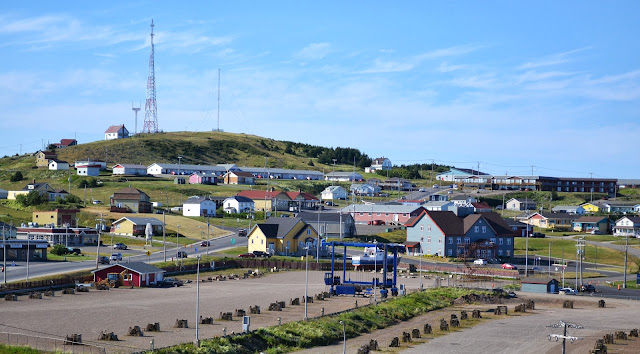Cap aux Meules Island is the second largest island in the
archipelago, has the largest population, and appears to be the hub for
businesses, schools, and tourism. The 2001 Census for the entire archipelago supported
a population of 12,818, down from 13,991 in 1991. The official 2006 census was
13,091. In 2012 the population totalled 13,062; five percent of those are
English speaking.
 |
| Looking up at the lookout |
 |
| Cap aux Meules Harbour |
As we travel around the islands the best place to eat
seafood chowder was La Factorie. The lower part of the building is a seafood
processing plant, the top a restaurant. Can’t get any fresher than that. We had
tried to have supper here one evening with the whole group but unfortunately
two tour buses rolled in before us. That’s a good sign of good food.
 |
| Cafeteria Style Dining |
 |
| La Factorie Restaurant |
The
only place on all the islands that did not strike me as wanting to come back to
was Gros-Cap. The scenery was stunning however the smell of sewage at times was
over bearing.
The Church of Saint-Pierre in La Verniere sits just outside
the town of Cap-aux-Meules. It was first built in 1876 and is the second
largest wooden church in North America. It has been struck several times by
lightning. The wood used to rebuild was retrieved from shipwrecks.
Shortly after arriving at our campsite I helped a fellow
RVers with his water heater problem. It turned out he worked for the
microbrewery down the road. Well fancy that. Frederick was his name and he
invited us to tour the microbrewery and sample some of the island beer. Who
could pass up that?
They have 8 different kinds of beer ranging from a very
light flowery tasting beer to an almost black beer that has a creamy espresso
finish. The alcohol content ranged from 4.8% to a whapping 11%. Yes, we tried
everyone and yes we walked out with a six pack and a warm and fuzzy feeling.
 |
| Testing the home brew |
A very good example of coastal erosion is at Plague de la
Dugue. Everywhere on the archipelago there are signs posted telling people to
beware of overhanging cliffs. They are extremely dangerous both from above and
below.
A small gray sandstone island off the coast called Ile aux
Goelands or Gull Island is a birdwatchers paradise. Unfortunately this time of
year is not the best, just lots of Double-crested Cormorants.
La Cote is not only a fishing harbour but an area with
several unique art and craft boutiques, restaurants & cafes, and beautiful
sunsets. This is also a great location to get wonderful fresh seafood.
One of the more unique boutiques in La Cote is a place
called Le Flaneur. The artist has created dolls with strange little
personalities and expressions are ever changing just like the sea.
Sitting high above the sea and close to the cliffs edge is
the Cap du Phare Lighthouse.
 |
| Cap du Phare Lighthouse |
Further along the coast is Cap aux Maquereux which is an
example of how the sea has sculptured the shoreline. Again these cliffs can be
extremely danger hence the wooden rail.
One of the nicest beaches to view and walk can also be one
of the most dangerous due to the strong north winds and currents.
Further along the beach is an area where you can drive your
vehicle. Louis and I had been talking about it for some time. While everyone
sunbathed on the beach we went for a drive. Where is their sense of adventure?
As we travelled around the island we spotted little sheds.
Some with their tops up some down. Later I found out they are called “baroque”
meaning shed. Farmers use them even today to store their hay in. The roof works
on a pulley system. It can be raised to dry hay in good weather and then
lowered to protect the hay in bad weather. This baroque looks like it has seen
better days.
The last little village we explored on Cap aux Meules was
Cap Vert with its little marina, red cliffs, and multicoloured houses. We were pleasantly
surprised to find this boat just hanging out in the harbour.
 |
| Once fishing boat turned pirate ship |
In keeping with the tradition of the Iles de la Madeleine
you can see no two houses are painted the same colour.
 |
| Multi-coloured houses |






























No comments:
Post a Comment